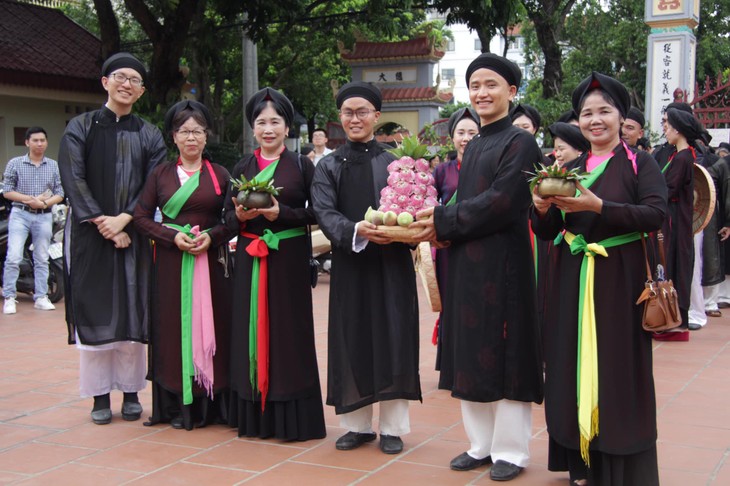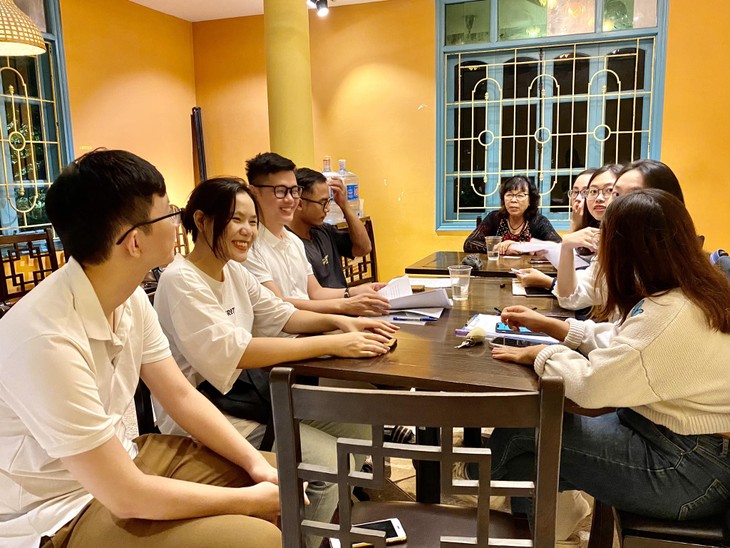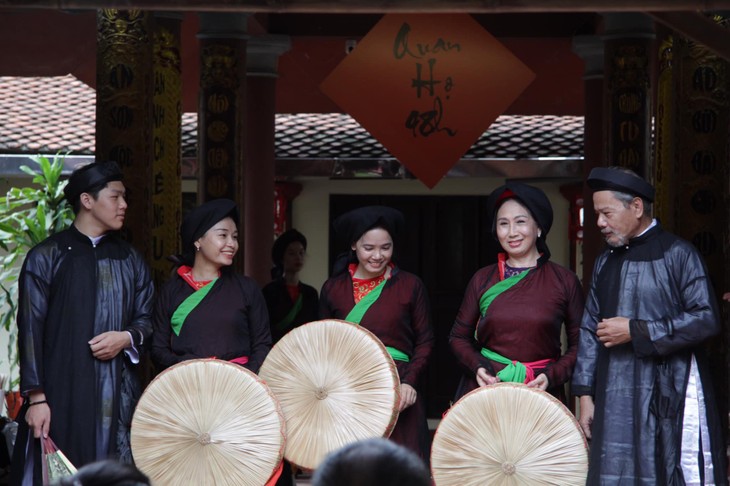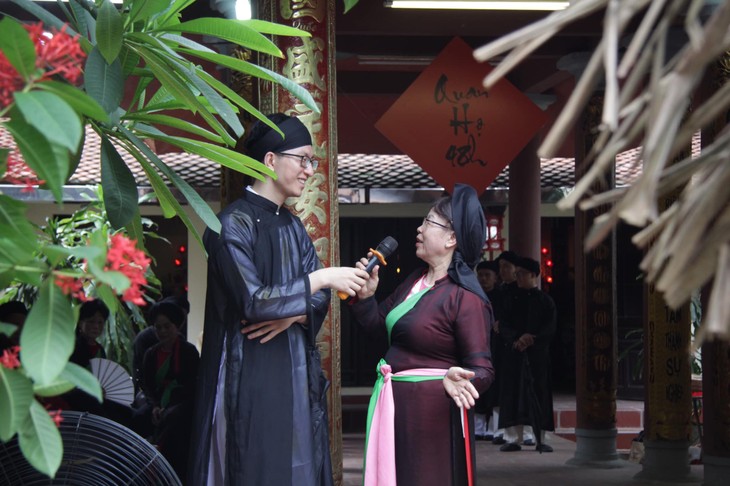 Cheo 48H Club organizes a Quan Ho session with senior Quan Ho artisans from Bac Ninh province.(photo: Quan Ho 48H Club) Cheo 48H Club organizes a Quan Ho session with senior Quan Ho artisans from Bac Ninh province.(photo: Quan Ho 48H Club) |
Quan Ho singing class connects senior artisans and young people
The Club members sing “Welcoming Guests to Our House”. Customarily when having guests, Quan Ho people invite them to have tea and betel leaves and areca nut and sing a song to show their emotion and hospitality.
Quan Ho singing is a special genre of Vietnamese folk music that originated in the Red River Delta province of Bac Ninh. Over the past 300 years, this genre of music has become an essential part of Vietnamese culture and a pride of all Vietnamese. In 2009, Quan Ho folk duet singing was recognized as an Intangible Cultural Heritage of Humanity by UNESCO.
Entering a Quan Ho singing class, you seem to indulge in sweet and soft melodies, which bring them to a peaceful and nostalgic ambience of Vietnam’s Red River villages.
 A class of the Cheo 48H Club meets every Saturday evening at 109 Nguyen Chi Thanh, Hanoi. (Photo: Cam Thi) A class of the Cheo 48H Club meets every Saturday evening at 109 Nguyen Chi Thanh, Hanoi. (Photo: Cam Thi) |
Participants of the Quan Ho class are young people who are studying and working in different sectors. They come here to live with their passion, says Tran Van Dung, a lawyer.
“I’m working at a law office. I was born in Bac Giang province, which is the home of Quan Ho on the northern side of the Cau River. I grew up with Quan Ho folk singing, listening to lullaby of my grandmother and mother. Quan Ho is performed at all events such as wedding parties, festivals, and New Year celebrations. I come to this Quan Ho class to live with my passion, to sing as a way to relax after work, and meet with young people who share the same passion,” Dung said.
Dinh Thi Thi Mai, a second-year student at the Tourism Study Faculty of the Hanoi University of Social Science and Humanity, says: “I’m lucky that when I was little, I listened to my grandparents singing and playing traditional musical instruments. I also play some traditional musical instruments. At school I learned about folk performance art and music genres without instrumental accompaniment. The more I learn folk music, the better I know about my country’s culture, its lifestyle, and the soul of the people. I joined the Club as a learner and a collaborator to improve my knowledge and organize activities to spread our love for folk music to many more people.”
Tran Trung Hieu participated in the first Quan Ho singing course and now continues with the second. “I’m creating content for a channel on Vietnamese culture, particularly cuisine. I want to learn more about Vietnamese traditions and folk art so I can better introduce Vietnamese culture to the world. The Club members are young. We learn Quan Ho singing and share passion about about Vietnamese traditions,” Hieu said.
Mrs. Nguyen Thi Nhu Chinh, whose stage name is Hai Chinh, explains the lyrics to help learners feel the songs and connect their emotions to the songs. Besides singing techniques, their knowledge of Quan Ho culture will help them sing emotionally and passionately, says Ms. Hai Chinh.
Quan Ho is not only beautiful in melody and lyrics, but also in its code of culture and the relationship among the singers. Hai Chinh is head of the Quan Ho Club Tri Am Tri Ki and Deputy Head of Quan Ho Nhi Ha Club for elderly people.
“I’m very happy to work with these young people. They are university students and have great passion for Quan Ho. My lessons for them are different from what I practice with old people. Young people learn singing as well as studying the cultural traditions. The more they learn, the more they are fond of traditional music. I see that many more young people come to folk music,” said Mrs Chinh.
 A Quan Ho mini show organized by Quan Ho 48H Club (photo: Quan Ho 48H Club) A Quan Ho mini show organized by Quan Ho 48H Club (photo: Quan Ho 48H Club) |
The locomotive of Cheo 48H Club
Nguyen Hoang Hiep, head of Cheo 48H Club said the idea of setting the Club came from the contest “When I’m 20” where they wanted to create a project to popularize Cheo and other folk music genres and bring them to life. Cheo is a style of popular theater traditionally performed in Red River Delta villages. Cheo is also a verb which means to row. Hiep said that Cheo 48H means they row long against wind and tide to return to their homeland, to their roots, and traditional values. Within 2 days or 48 hours, they hoped to inspire other young people to embrace Cheo.
Now, a 48‑hour course is not done in just two days but spreads over many days to match the schedule of the learners. Cheo 48H also organizes courses in other folk music genres such as Xam singing and Quan Ho folk duet singing.
 Nguyen Hoang Hiep and a senior Quan Ho artisan (photo: Cheo 48H Club) Nguyen Hoang Hiep and a senior Quan Ho artisan (photo: Cheo 48H Club) |
“The youngest learners at our Club are primary school pupils. We also have senior learners at 70‑years‑old and older. Recently we have more learners from Gen Z, which shows that traditional music and art can attract people of different generations. Sometimes many participants in the class are 20‑years different and the atmosphere was quite similar to a communal festival. Young and old men and women gathered here to sing together. Our initial target learners were young people. But we are now open to children and older people as well,” said Hiep.
Hiep graduated from the Literature Faculty of the Hanoi National University of Social Science and Humanity. He did a tertiary thesis on Cheo and since then has nurtured a strong attachment to folk art. At Cheo 48H Club he has organized courses on Xam (singing of visually impaired people), Chau Van (trance singing and dancing), and Quan Ho folk duet singing. Hiep is also an active member of the Center for the Promotion of Vietnamese Intangible Cultural Heritages.
Cheo 48H club aims to organize core groups to sow the seeds of love for folk art at universities and in localities, said the founders. Bringing traditional art to schools and organizing community events have drawn more young people to Cheo 48H.
Hiep said that they recently organized a Quan Ho session with a traditional format – singing without instrumental accompaniment and preparing betel leaves and areca nut. "We also had a show of traditional costumes. The event welcomed people who have never attended a Quan Ho singing session. They came by chance but then found it interesting and wanted to learn more about Quan Ho," said Hiep.
Dinh Thi Thi Mai, a second-year student at the Tourism Study Faculty of the Hanoi University of Social Science and Humanity, shared her view: "Young people love modern music such as V‑pop and K‑pop. Cheo 48H aims to popularize folk music among young people so we have to be creative in our performance and organization. So we add more features to the old‑form performance of folk arts. We organize a Quan Ho singing session at the Mid‑Autumn Festival and mini shows for the learners to practice. We have also invited senior artists and experts to attend our performance to exchange their experience”.
Teacher Chinh said she has helped the Club organize activities and appreciates the young people’s creative minds. The organizers have stuck to their dual goals of creating entertainment and spreading traditional culture. They learn the old form of Quan Ho and promote it using a creative and modern approach.
“They have organized a very interesting show to close the first Quan Ho course. They left a deep impression on the audience. A month before the performance, they launched a communication program on social media to reach more people. The Quan Ho session was venue for Quan Ho lovers as well as those who want to learn more about Quan Ho. I believe they will be successful in spreading their passion to other young people and guide them back to their national roots,” Mrs. Chinh said.
Hiep said that the Quan Ho sessions have inspired both young and old Quan Ho singers and created an affectionate atmosphere. Young people are happy to meet and to perform side by side with their idols and senior Quan Ho artists said they are proud and eager to share their passion and experience to the community. At the age of 50 and older, they realize that nurturing a successor generation is the most important thing.
“We’ll have more young people working seriously, professionally to promote traditional culture. Their passion and dedication have encouraged and given us more energy to hand down our knowledge," said Mrs. Chinh. They have co‑organized Quan Ho sessions with Clubs of senior artists and invited artists from Bac Ninh province. People of different ages have established a close bond as family members.
From an initial purpose of promoting Cheo in 2014, after nearly 10 years Cheo 48H has expanded its operation and influence. Hiep said: “We have organized courses on Chau Van, Cheo, and Xam. We plan to promote other music genres of the northern region and have ambition to communicate other cultural heritages of Vietnam’s 54 ethnic groups which have many unique cultural values. In the near future, we’ll launch courses on Tuong and Ca Tru, two art forms which are difficult to touch young audience.”